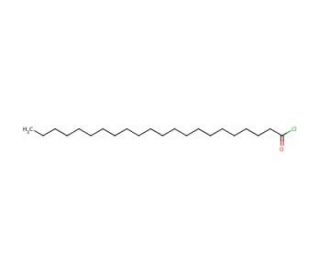

Behenoyl chloride (CAS 21132-76-3)
QUICK LINKS
Behenoyl chloride is a chemical compound that functions as an acylating agent in organic synthesis. It is used to introduce the behenoyl group into various organic molecules, serving as a key step in the production of specific compounds. The mechanism of action of behenoyl chloride involves the reaction of the acyl chloride group with nucleophiles, leading to the formation of new carbon-carbon or carbon-heteroatom bonds. Behenoyl Chloride reaction occurs through nucleophilic acyl substitution, where the behenoyl chloride molecule acts as an electrophile, attracting nucleophiles to undergo substitution reactions. This process allows for the modification of organic molecules, enabling the synthesis of new compounds with tailored properties. Behenoyl chloride′s mechanism of action at the molecular level involves the transfer of the behenoyl group to specific sites within the target molecules, leading to the desired structural modifications.
Behenoyl chloride (CAS 21132-76-3) References
- Identification of triacylglycerol species from high-saturated sunflower (Helianthus annuus) mutants. | Fernández-Moya, V., et al. 2000. J Agric Food Chem. 48: 764-9. PMID: 10725146
- Cytarabine conjugates with biologically active molecules and their potential anticancer activity. | Novotny, L. and Rauko, P. 2009. Neoplasma. 56: 177-86. PMID: 19309219
- Development and optimization of oil-filled lipid nanoparticles containing docetaxel conjugates designed to control the drug release rate in vitro and in vivo. | Feng, L., et al. 2011. Int J Nanomedicine. 6: 2545-56. PMID: 22072889
- Optimization of self-assembling properties of fatty acids grafted to methoxy poly(ethylene glycol) as nanocarriers for etoposide. | Varshosaz, J., et al. 2012. Acta Pharm. 62: 31-44. PMID: 22472447
- 2'-Behenoyl-paclitaxel conjugate containing lipid nanoparticles for the treatment of metastatic breast cancer. | Ma, P., et al. 2013. Cancer Lett. 334: 253-62. PMID: 22902506
- N(4)-Acyl derivatives as lipophilic prodrugs of cidofovir and its 5-azacytosine analogue, (S)-HPMP-5-azaC: chemistry and antiviral activity. | Krečmerová, M., et al. 2014. Bioorg Med Chem. 22: 2896-906. PMID: 24731540
- Dependence of the bilayer to hexagonal phase transition on amphiphile chain length. | Epand, RM., et al. 1989. Biochemistry. 28: 9398-402. PMID: 2611238
- Pharmaceutical organogels prepared from aromatic amino acid derivatives. | Bastiat, G. and Leroux, JC. 2009. J Mater Chem. 19: 3867-3877. PMID: 27099412
- Development of Novel Low-Molecular-Mass Oil-gelling Agents: Synthesis and Physical Properties of 1,5-Anhydro-D-glucitol and 1,5-Anhydro-D-mannitol Protected with Saturated Linear Fatty Acids. | Kajiki, T. and Komba, S. 2019. J Appl Glycosci (1999). 66: 103-112. PMID: 34429688
- Synthetic vaccines targeting Mincle through conjugation of trehalose dibehenate. | Hanna, CC., et al. 2022. Chem Commun (Camb). 58: 6890-6893. PMID: 35638863
Ordering Information
| Product Name | Catalog # | UNIT | Price | Qty | FAVORITES | |
Behenoyl chloride, 1 g | sc-214577 | 1 g | $150.00 |
